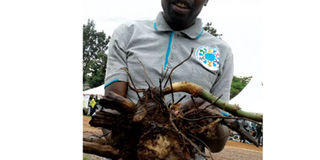How to profit from climbing yams

Mubarak Kabagamba displays a harvested balugu yam. Photo Lilian Namagembe.
What you need to know:
The taste of aerial yam is close to that of potatoes, but it is a little harder in the inside, writes Lilian Namagembe.
In the heart of Buikwe, there is a small farm that has become the talk of the district.
The farm measuring 100m by 50m belongs to Mubarak Kabagambe, and hosts aerial yams, which are also known as climbing yams. The plant is a semi-wild food that grows on vines climbing onto poles and trees. The bulb is eaten on peeling off the hard back after cooking. The plant’s heart-shaped leaves with slender twinning vines spread tenaciously on posts Kabagambe has erected.
“The leaves and vines of the crop are currently dry, which means it is harvest time.”
Why climbing yams
Kabagambe chose to take advantage of his job appointment in Buikwe District and started growing the area’s favourite food -climbing yams. He has no regrets. Kabagambe says he went for yams to carve a niche for himself. He is introducing farmers to climbing yams, which according to him have turned his life for the better and helped him put around his children through school.
“I switched from coffee to the yams after seeing their potential some three years ago. A friend in Mukono introduced them to me.”
It was the start of his flourishing climbing yam business, which is gaining popularity among farmers. He planted the single yam and in six months harvested 15 yams.
“I replanted and expanded the farm and six months later realised some good harvests. However, because the yam was not common in the market, I lacked a ready market making me explore other avenues,” says Kabagambe who participated in the 9th edition of the Annual Indigenous and Traditional Food Fair exhibition organised by Participatory Ecological Land Use Management (PELUM) in October.
Agronomy
Because it is a climbing yam, Kabagambe says it is not an option to plant the yam next to a tree. The yams are planted inside rectangular holes. Seed yams (tubers harvested during the previous season) are placed on top of
soft soil and covered with a layer of dry grass, which protects them without preventing the shoots
from growing. When the plants start to sprout, the shoots are directed toward the trunk of the nearest tree such as the ficus natelensis, known as omutuba in Luganda. The yam vines climb up the tree, reaching its crown before coming down again.
The vines of climbing yams are in fact dozens of metres long, and the plants have spiny branches at the base. “The spines collect water so the plants can survive dry periods,” says Kabagambe. Climbing yams are grown together with various vegetables such as cabbage, pumpkin, beans (including the tiny local varieties ntinamuti and nkolimbo), matooke, and other banana varieties.
Harvest
Climbing yams become productive after nine months and the tubers vary greatly in size, from less than five kilogrammes up to 80 and 100 kilogrammes for the kyetutumula variety.
The yams are ready for harvest when the plants have dried out and lost all of their leaves. In order to extract the yams, the farmer digs down three metre deep, hoeing the soil around and underneath the tubers so that they can be pulled out without being damaged. “Before harvesting, starve the beds of water for two weeks to allow them to harden. This gives room for the tubers to shed much of the water and develop a floury texture when cooked. The moisture bed is watered on the harvesting day to ease uprooting of the tubers.”
Pests, diseases
As the crop grows, one should scout for pests and diseases such as tuber rotting caused by worms that bore into the produce.
The worms are kept at bay by use of ash to lower soil acidity, which makes them thrive.
Market
Kabagambe makes sales of up to Shs500,000 in a day during agricultural exhibitions.
He also has a retail shop in Buikwe market where he says he makes up to Shs150,000 a week.




